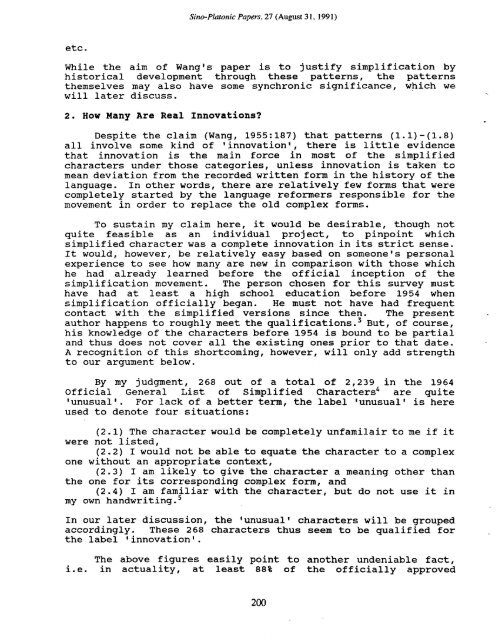Essays on Writing and Language in Honor - Sino-Platonic Papers
Essays on Writing and Language in Honor - Sino-Platonic Papers
Essays on Writing and Language in Honor - Sino-Platonic Papers
You also want an ePaper? Increase the reach of your titles
YUMPU automatically turns print PDFs into web optimized ePapers that Google loves.
etc.<br />
S<strong>in</strong>e-Plat<strong>on</strong>ic <strong>Papers</strong>, 27 (August 3 1, 1 99 1 )<br />
While the aim of Wang's paper is to justify simplificati<strong>on</strong> by<br />
historical development through these patterns, the patterns<br />
themselves may also have some synchr<strong>on</strong>ic significance, which we<br />
will later discuss,<br />
2. How Many Are Real ~nnovati<strong>on</strong>s?<br />
Despite the claim (Wang, 1955: 187) that patterns (1.1) - (1.8)<br />
all <strong>in</strong>volve some k<strong>in</strong>d of '<strong>in</strong>novati<strong>on</strong>', there is little evidence<br />
that <strong>in</strong>novati<strong>on</strong> is the ma<strong>in</strong> force <strong>in</strong> most of the simplified<br />
characters under those categories, unless <strong>in</strong>novati<strong>on</strong> is taken to<br />
mean deviati<strong>on</strong> from the recorded written form <strong>in</strong> the history of the<br />
language. In other words, there are relatively few forms that were<br />
completely started by the language reformers resp<strong>on</strong>sible for the<br />
movement <strong>in</strong> order to replace the old complex forms.<br />
To susta<strong>in</strong> my claim here, it would be desirable, though not<br />
quite feasible as an <strong>in</strong>dividual project, to p<strong>in</strong>po<strong>in</strong>t which<br />
simplified character was a complete <strong>in</strong>novati<strong>on</strong> <strong>in</strong> its strict sense.<br />
It would, however, be relatively easy based <strong>on</strong> some<strong>on</strong>e's pers<strong>on</strong>al<br />
experience to see how many are new <strong>in</strong> comparis<strong>on</strong> with those which<br />
he had already learned before the official <strong>in</strong>cepti<strong>on</strong> of the<br />
simplificati<strong>on</strong> movement. The pers<strong>on</strong> chosen for this survey must<br />
have had at least a high school educati<strong>on</strong> before 1954 when<br />
simplificati<strong>on</strong> officially began. He must not have had frequent<br />
c<strong>on</strong>tact with the simplified versi<strong>on</strong>s s<strong>in</strong>ce then. The present<br />
author happens to roughly meet the cpalif icati<strong>on</strong>s .3 But, of course,<br />
his knowledge of the characters before 1954 is bound to be partial<br />
<strong>and</strong> thus does not cover all the exist<strong>in</strong>g <strong>on</strong>es prior to that date.<br />
A recogniti<strong>on</strong> of this shortcom<strong>in</strong>g, however, will <strong>on</strong>ly add strength<br />
to our argument below.<br />
By my judgment, 268 out of a total of 2,239 <strong>in</strong> the 1964<br />
Official General List of Simplified characters4 are quite<br />
Iunusual1. For lack of a better term, the label gunusual' is here<br />
used to denote four situati<strong>on</strong>s:<br />
(2.1) The character would be completely unfamilair to me if it<br />
were not listed,<br />
(2.2) I would not be able to equate the character to a complex<br />
<strong>on</strong>e without an appropriate c<strong>on</strong>text,<br />
(2.3) I am likely to give the character a mean<strong>in</strong>g other than<br />
the <strong>on</strong>e for its corresp<strong>on</strong>d<strong>in</strong>g complex form, <strong>and</strong><br />
(2.4) I am familiar with the character, but do not use it <strong>in</strong><br />
my own h<strong>and</strong>writ<strong>in</strong>g.<br />
In our later discussi<strong>on</strong>, the lunusualf characters will be grouped<br />
accord<strong>in</strong>gly. These 268 characters thus seem to be qualified for<br />
the label '<strong>in</strong>novati<strong>on</strong>1.<br />
The above figures easily po<strong>in</strong>t to another undeniable fact,<br />
i.e. <strong>in</strong> actuality, at least 88% of the officially approved

















